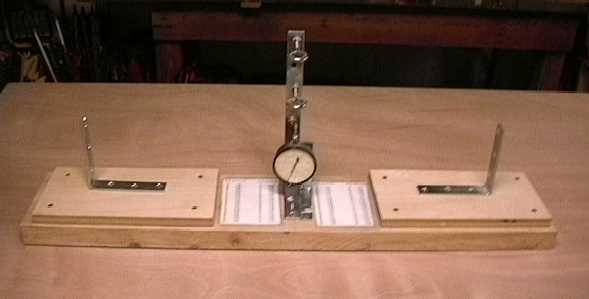
Here is my homemade arrow shaft spine tester. It uses common hardware
purchased at my local hardware store and a
dial indicator that I picked up on E-Bay. Total cost, including the dial
indicator, was less than $50.
If there is anything original about it (doubtful), it is the weight arrangement. I have never liked the idea of the weight hanging beside the measuring point on the shaft, as it does on the other spine testers I've seen. I suppose it works OK, but it just bugs me. I wanted to place the two pound weight directly over the center of the shaft and the dial indicator plunger directly under it. It just seems simpler and more precise to me.

Just to review, the spine or spline of an arrow shaft is a measure of its' stiffness. The accepted standard for measuring spine is to measure the deflection of the shaft at the midpoint of a 26 inch span when placed under a two pound load. The more deflection, the less stiff the shaft, which is to say the lower its' spine measurement.
You can use the raw deflection measurement itself, for example .436 inches. Or you can compute the spine using the formula 26/deflection in inches=spine. For example, 26 divided by .436 equals 59.6. You can express the spine of that shaft as .436 inches or as 59.6 pounds. It doesn't matter whether you express the spine (stiffness) of the arrow in inches, pounds or light years. As long as you use the same method consistently, you will get the right arrows for your bow. If your bow shoots best with arrows of spine "X" (inches, pounds, light years, whatever), build your arrows with shafts of that spine.
The function of a spine tester is to support an arrow shaft on two points that
are 26 inches apart, place a 2 pound load on the shaft at the midpoint of the 26
inch span and measure the deflection as accurately and consistently as possible.
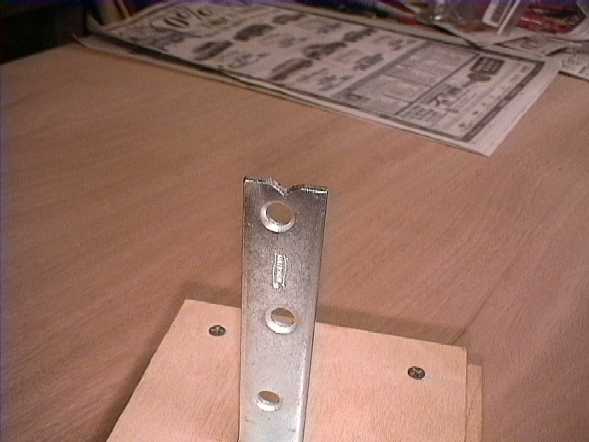
The arrow shaft supports are 90 degree angle brackets placed exactly 26 inches apart, with a notch filed into the top edge of each to hold the arrow shaft. The photo above shows the notch in one of the supports.
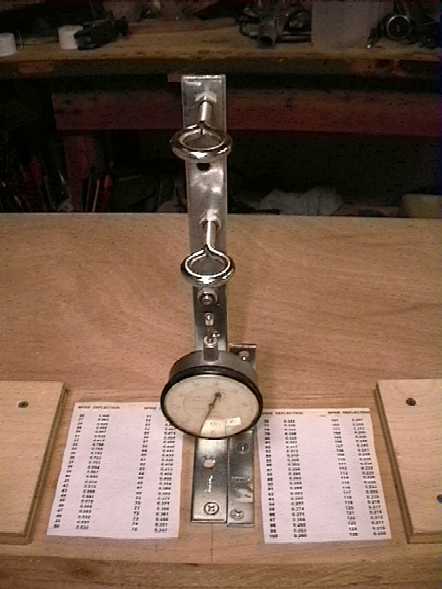
The dial indicator is mounted on an angle bracket exactly midway between the two supports, 13 inches from each. It is mounted at a height that will allow an arrow shaft to barely touch the plunger of the indicator and displace it by a small amount when the shaft is placed on the supports. Of course, the dial indicator must be placed precisely under the bottom of the arrow shaft as the latter rests on the supports. A little judicious bending of the angle bracket accomplishes this.
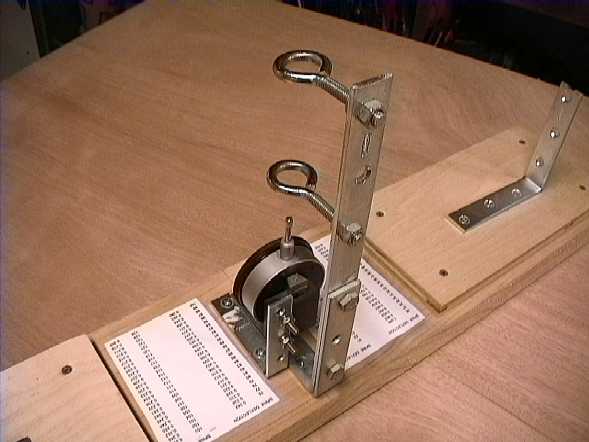
Another (larger) angle bracket is mounted beside the first. It holds two eye bolts that serve to hold the 2 lb. weight in a vertical position. They are carefully adjusted to place the center of each eye directly over the dial indicator shaft. NOTE! It is very important that the weight is a close fit through the eyes of the eye bolts, so that it is held in a vertical position. My weight is a 3/4 inch bolt, which fits closely through two 3/4 eye bolts.

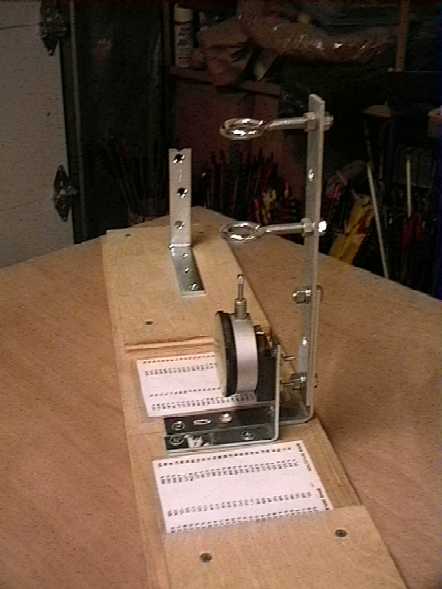
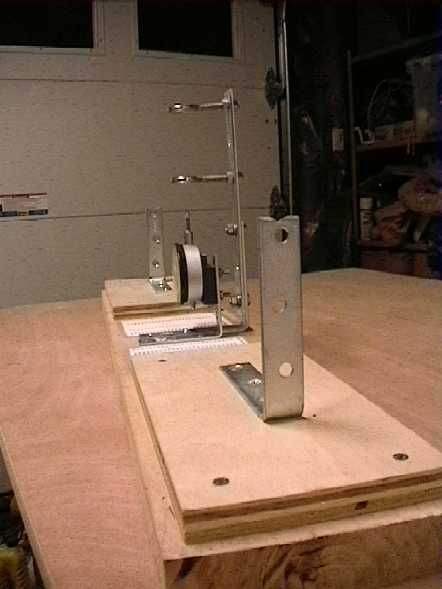


The two pound weight is a 3/4 inch diameter hex bolt (8 inches long under the head) with enough washers to bring it up to just less than two pounds as measured on the hardware store bulk nail scale. I used epoxy to glue all of the washers together at the head end of the bolt. Then I took that bolt/washer assembly to my grocery store seafood department, which has a good digital scale that registers to the hundreth of a pound. I had them weigh the assembly and noted the weight. I subracted that figure from two pounds and converted the difference to grains (1 ounce equals 437.5 grains). Then I took some lead fishing weight and, using a knife and my reloading grain scale, I cut the lead until it was exactly what I needed to make the weight up to two pounds. I epoxied the lead to the very top of the bolt head. It is the grey blob on the head of the bolt in the photo.

Here you see the tester before putting the shaft on the supports. You can't see it well in this photo, but the needle is indicating zero deflection, as you would expect.
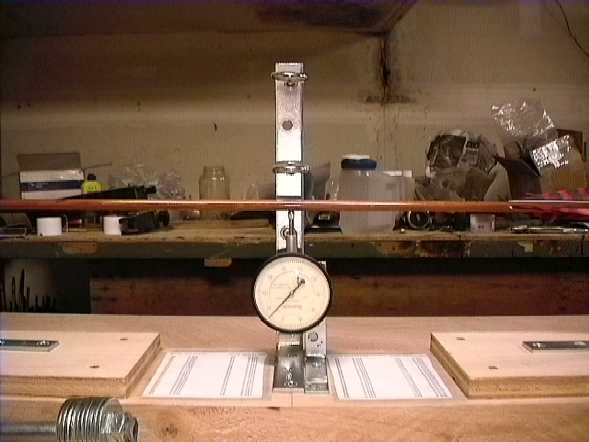
I adjusted the height of the dial indicator so that a shaft would always depress the plunger a little, even without a load, in order to ensure a positive contact. As you see, the needle has moved. I keep the dial loose, so that I can rotate it to align the zero index with the needle in this position. After adjusting the dial, I lower the two pound weight through the eye bolts to rest on the arrow shaft, .
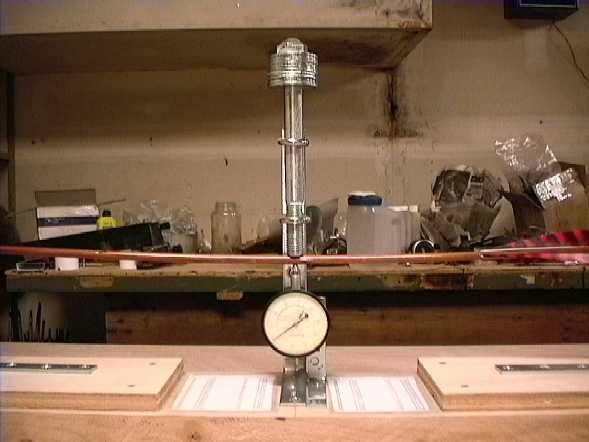
Here you see the weight in position on the arrow shaft. I note the deflection measurement on the dial and compare it to a spine-deflection table that I made up and taped to the base of the tester.
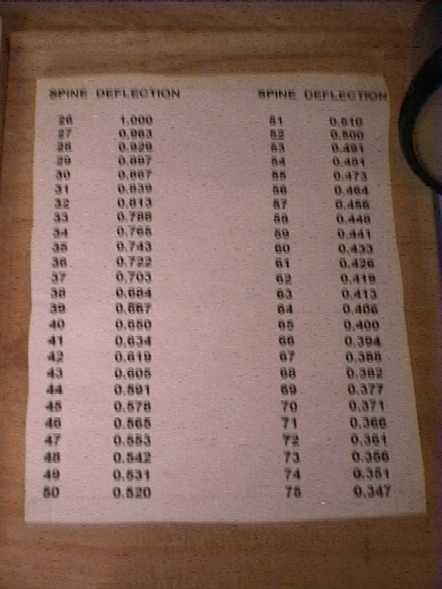
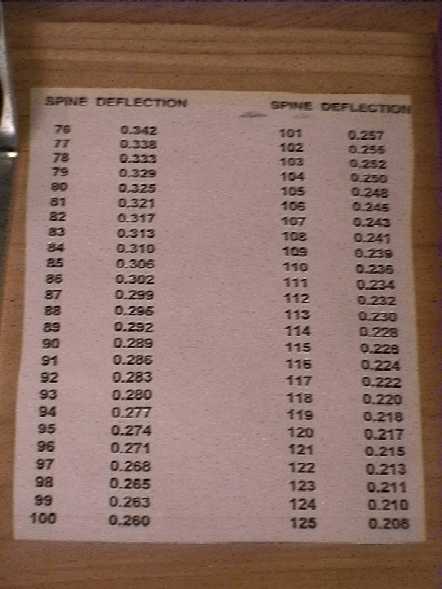
Here is a better spine vs. deflection table:

NOTE! Don't make the mistake I did. Use a dial indicator that has a full one inch measurement capability. You need it if you want to measure the lighter spine shafts. My indicator is a nominal half-inch model. Actually, it goes to .565 in. So I can meaure shafts that deflect up to .565 under a two pound load, but no more. Since 26 divided by .565= 46, I can measure the spine of any shaft equal to or GREATER than a 46 lb. spine, but no lighter than that. If, for example, you need to measure a 40 lb. spine shaft, you need an indicator that can measure a .65 inch displacement. Mine can't. The plunger bottoms out at .565 in.
Sorry. I don't have plans or measurements to offer, because dial indicators come in a number of sizes, and everything is sized to work with the dial indicator that you have. You have to custom fit everything to the dial indicator. If you study the photos you will be able to figure it all out.
If you have any questions or suggestions on how to make this page more helpful, email me at jameshill@ak.net .
All the best to you.